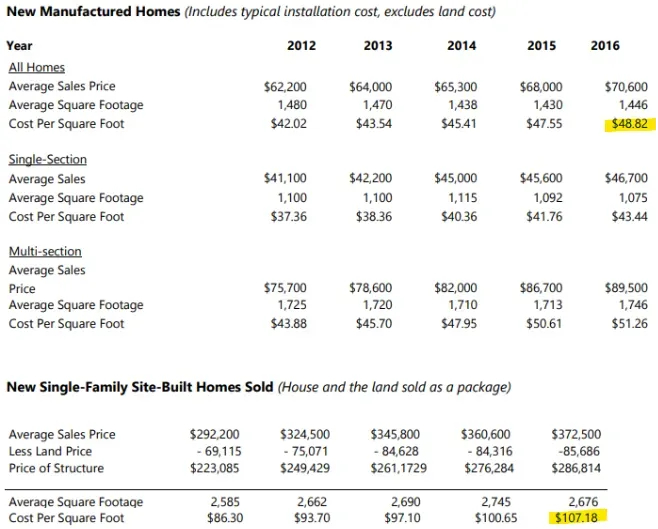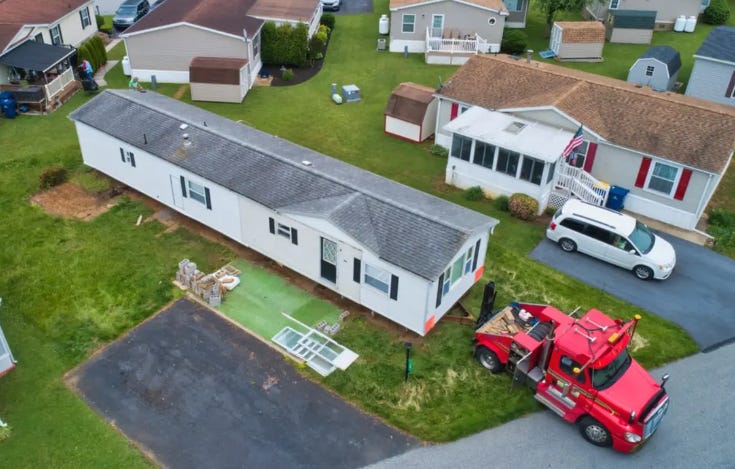Wheel Estate
By 1974 mobile homes were produced by over 300 firms in 800 plants across the country, and across the country 9 million people were living in nearly 4 million mobile homes. According to Forbes, the top 3 most profitable companies between 1968 and 1973 were mobile home manufacturers

Capital Thinking • Issue #1156 • View online
A recurring theme of this newsletter is the failure of prefabrication (building homes in factories instead of on-site) to revolutionize the housing industry.
While it’s possible to build a successful construction business with prefabrication, it hasn’t swept away the old methods of building - building a home on-site remains the most common (and in most cases, the cheapest) way of building a house in the US. (Outside the US, prefabrication is often more popular, but it’s still not a low-cost method of building.)
No one has yet managed to do for housing what Ford did for cars, or what Corning did for lightbulbs, or what Arkwright, Hargreaves, and Crompton did for cotton thread.
The Rise and Fall of the Manufactured Home - Part I
Brian Potter | Construction Physics:
However, one form of prefabrication is able to reliably produce housing substantially cheaper than site-built methods - the manufactured home (formerly the mobile home, also called trailer homes or HUD homes.)
Manufactured homes are a particular type of factory-built housing that isn’t required to meet local building codes - instead, manufactured homes are built to the Manufactured Home Construction and Safety Standards, a federal standard administered by HUD.
Manufactured homes have an average per-square-foot cost that’s less than half the cost of the average site-built home

(This is a somewhat misleading statistic, as site-built homes will be higher-end than manufactured homes on average and thus more expensive for reasons unrelated to production efficiency. Comparing like for like, the cost-per-square-foot of a manufactured home is somewhere around 10-35% less than the cost of a site-built home.)
Despite their lower cost, manufactured homes today make up a relatively small portion of the housing market.
In 2021 manufactured homes were just over 6% of new housing units, with just over 100,000 manufactured homes shipped compared to 1.6 million single family and multifamily housing starts.
But this wasn’t always the case - at its peak in the early 1970s, the mobile home industry (they didn’t “officially” become manufactured homes until 1980) was shipping 600,000 homes a year, and mobile homes were over 20% of new housing units.

(One statistic you sometimes see is that at one point mobile homes made up 60% of total new houses - this is incorrect. At one point mobile home units were around 50% of the number of single family homes built.)
Since lately there’s been renewed interest in manufactured homes as a potential low-cost housing solution, it’s useful to understand how the industry got to where it is.
Why did manufactured homes explode in popularity only for the industry to collapse a few years later? Why aren’t manufactured homes more widely used today?
Let’s take a look.
Origins of the manufactured home
The manufactured home can trace its origins to early 20th century camping trailers.
In the 1910s and 1920s, car adoption was rapidly increasing - in 1910, there were around 500,000 cars in the US, which by 1925 had increased to 17.5 million cars. Car owners would often use their cars to go on camping trips, an activity which became known as “autocamping.”
To avoid having to pack and unpack the campsite, and to get more comfort than a tent could provide, people began to build camping trailers that could be towed behind the car - by 1936 it was estimated that there were 300,000 camping trailers in the US.
It’s estimated that around 75% of those trailers were homemade, but over time commercially-built ones became more popular. By 1936 most new trailers were purchased from commercial builders, and manufacturers were producing 55,000 trailers a year.

Early on, autocampers would park by the side of the road, or in a farmer’s field, or any other available space. But as camping became more popular, this became less tenable - a small town on a main road “might expect to see fifty to sixty cars seeking sites each night” [1].
Municipalities began to build campgrounds to accommodate the campers - between 1920 and 1924, an estimated 3 to 6,000 municipal campgrounds were built. And as camping trailers became more popular, campgrounds designed exclusively for trailers began to appear.
These became known as “trailer parks.”
Almost as soon as trailers appeared, they began to be used for year-round living rather than camping trips, typically by traveling salesman or other itinerant workers.
In the 1920s and 30s it was estimated that between 10 and 25% of trailers were used for year-round accommodation. And as unemployment soared and housing starts collapsed during the Great Depression, trailer living became more common.
By 1937, it was estimated that 50% of new trailers were purchased as permanent shelter.
Then, as now, permanent trailer living was stigmatized. A 1937 article in Fortune described permanent trailer camps as “crooked rookeries of itinerant flophouses.”
Many municipalities, such as Detroit and Toledo, placed maximum allowable times that trailers could be parked to try to prevent the appearance of “trailer shantytowns”. Lawsuits (such as People vs Gumarsol) were filed against trailer occupants who tried to occupy their trailers permanently.
The trailer industry had a delicate balance to strike - trailer living was becoming more common, which required favorable treatment by municipalities to allow trailer placement.
But manufacturers also wanted to ensure that trailers remained classified as vehicles, rather than housing, to avoid having to comply with onerous building regulations and avoid conflict with building trade unions.
In 1936, trailer manufacturers formed the Trailer Coach Manufacturers Association (TCMA) to advocate for legislative priorities, encourage favorable regulation, and ensure that trailers continue to be treated by governments as vehicles, rather than housing.

*Featured post photo by Roger Starnes Sr on Unsplash
